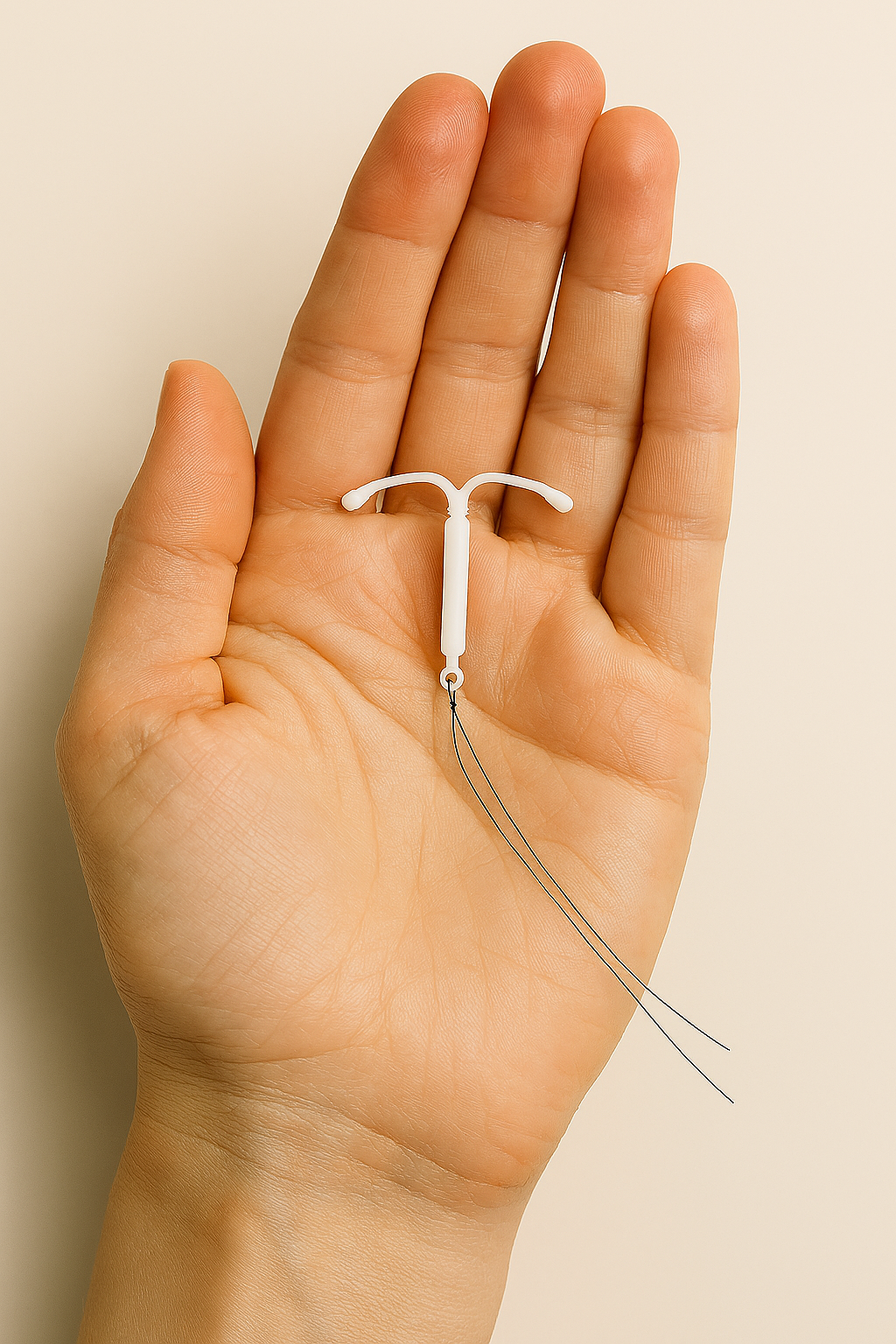
IUD INSERTIONS
Mona Vale Doctors now offers IUD (Intrauterine Device) insertions
Why choose an IUD?
99.9% effective
IUDs are among the most reliable forms of contraception, with a failure rate of less than 1 in 100 - making them highly effective at preventing pregnancy.
‘Set and Forget’ Convenience
The Mirena IUD lasts up to 8 years, offering long-term protection without the need to remember a daily pill - ideal for those seeking a low-maintenance option.
Fully reversible
Fertility returns quickly after removal, making IUDs a great choice for those who may wish to conceive in the future.
Relief from Heavy Periods
Hormonal IUDs like Mirena can significantly reduce heavy menstrual bleeding and cramping, improving quality of life for many women.
Menopausal Hormone Therapy (MHT)
For women with an intact uterus using oestrogen therapy (via pill, patch, or gel), the Mirena IUD can serve as the required progesterone component to protect the uterine lining.
Expert Care at Mona Vale Doctors
IUDs are inserted in-clinic by Dr Michelle Penm, ensuring safe and professional care in a comfortable setting.
What to Expect
1. CONSULTATION
Your IUD journey begins with a comprehensive consultation with one of our doctors. During this appointment, we’ll:
Discuss your personal health needs and goals
Assess your suitability for an IUD
Answer any questions or concerns you may have
This ensures you’re fully informed and confident before proceeding with the insertion.
2. PROCEDURE
Insertion is performed by Dr Michelle Penm. The procedure itself takes around 30 minutes, but we recommend allowing up to 1 hour for your visit to include rest and recovery time afterward.
To help manage discomfort, take Ibuprofen or Paracetamol about one hour before your appointment, unless advised otherwise by your doctor.
A local anaesthetic may be applied to the cervix before insertion, though this is not always necessary. You may experience cramping during the procedure, which usually settles quickly. Some women may also feel light-headed or faint immediately after insertion - this is temporary and typically resolves with rest.
3. FOLLOW-UP
After the procedure, most patients feel well enough to drive and resume normal activities.
A follow-up appointment is scheduled for 6 weeks after insertion to ensure the IUD is correctly positioned and everything is progressing well.
If you have any questions or concerns at any point after the procedure, our team is here to support you—please don’t hesitate to get in touch.
Frequently Asked Questions
-
An IUD or intra-uterine device is small, plastic T-shaped device placed inside the uterus to prevent pregnancy. There are two main types of IUDs - hormonal and copper. Mona Vale Doctors offers insertion of hormonal IUDs - Mirena and Kyleena. Both contain the synthetic form of the hormone progesterone levonorgestrol. The Kyleena IUD is slightly smaller and has a lower level of levonorgestrol. With the Kyleena, you are also most likely to have a period (though usually lighter than before) whereas with a Mirena, having no period (or a lighter period) is more common. The Mirena has contraceptive effect for 8 years and the Kyleena has contraceptive effect for 5 years.
-
Its release of levonorgestrol provides contraceptive effect in three main ways:
Thickening of cervical mucous, which makes it harder for sperm to enter the uterus;
Thinning of endometrium (inner lining of the uterus), making it less suitable to implantation;
Partially suppressing ovulation (monthly release of an egg from the ovary).
-
Yes, most women are suitable candidates for an IUD. IUDs are a safe and effective option for a wide range of individuals, including those who:
Cannot take oestrogen due to medical contraindications such as migraines with aura or a history of deep vein thrombosis (DVT).
Prefer to avoid oestrogen-based contraception due to side effects or personal choice.
Struggle with daily pill adherence, making a long-acting method more practical.
Want a more reliable contraceptive than condoms or the withdrawal method.
Seek a low-maintenance, cost-effective, reversible, and long-term solution for contraception.
Wish to space out pregnancies.
Use the Mirena IUD as part of menopausal hormone therapy (MHT) for its progesterone component.
Experience heavy menstrual bleeding (HMB) and are looking for symptom relief.
-
Yes, you can. Many women who haven’t had children choose the smaller Kyleena IUD, which is designed to be more comfortable for those who haven’t given birth. However, the Mirena IUD is also suitable, especially if you're using it to manage heavy menstrual bleeding (HMB) or as the progesterone component of menopausal hormone therapy (MHT) - uses for which Kyleena is not approved.
-
We usually recommend to wait 9 weeks after you have had a vaginal birth and 12 weeks if you have had a caesarean section. There is a higher risk of the IUD being pushed out (expelled) or damaging the uterine wall (perforation) if it is inserted earlier.
-
Yes, you can. Hormonal IUDs are safe to use while breastfeeding and do not affect your milk supply.
However, research shows that the risk of uterine perforation - where the IUD may puncture the uterine wall - is slightly higher in breastfeeding women, particularly if the IUD is inserted within 36 weeks postpartum. While the risk is about six times higher compared to non-breastfeeding women, it remains very low overall, estimated at up to 12 cases per 1,000 insertions.
Your doctor will assess the best timing for insertion to minimise risks and ensure safe placement.
-
No, IUDs do not offer protection against STIs. To reduce the risk of sexually transmitted infections, it’s important to use condoms.
-
Yes, while IUDs are safe and effective for most women, there are certain medical conditions where they may not be recommended. These include:
Current breast cancer (for hormonal IUDs only)
Active pelvic infection, such as pelvic inflammatory disease (PID)
Unexplained vaginal bleeding that has not been investigated
Severe liver disease (for hormonal IUDs)
Uterine abnormalities, such as fibroids that distort the shape of the uterine cavity
It’s important to speak with your doctor to determine whether an IUD is appropriate for your individual health needs and circumstances.
-
Like any medical procedure, IUD insertion carries some risks and side effects. These include:
Cramping or discomfort during and shortly after insertion - this usually settles within a few days.
Irregular bleeding or spotting, especially in the first few months after insertion.
Hormonal side effects (with hormonal IUDs like Mirena), which may include acne, headaches, or mood changes.
Your doctor will discuss these risks and side-effects in detail with you and help determine whether an IUD is the right option based on your health and preferences.
-
To get started, call our reception to book a consultation with one of our doctors. During this appointment, you can discuss whether an IUD is suitable for your needs and preferences.
If you decide to proceed, the IUD insertion will be performed by Dr Michelle Penm at a follow-up appointment.

Explore your options for long-term, reliable and reversible contraception with our experienced doctors.
Book your IUD consultation today and take control of your reproductive health at Mona Vale Doctors.



